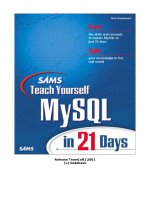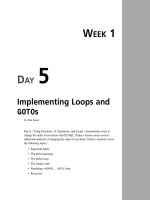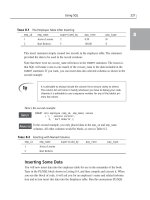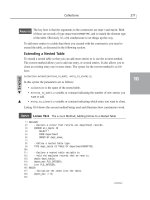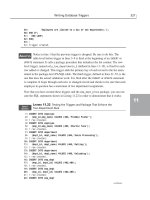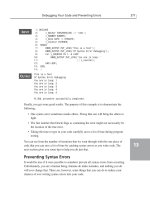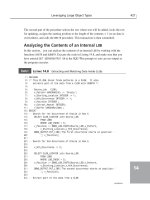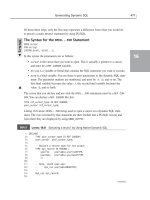Tài liệu Teach Yourself PL/SQL in 21 Days- P13 ppt
Bạn đang xem bản rút gọn của tài liệu. Xem và tải ngay bản đầy đủ của tài liệu tại đây (2.3 MB, 50 trang )
PL/SQL and Java 577
20
L
ISTING
20.11
Publishing a Java Method with an OUT Argument
1: CREATE OR REPLACE PROCEDURE get_super_name2 (
2: emp_id IN NUMBER,
3: emp_name OUT VARCHAR2)
4: AS LANGUAGE JAVA
5: NAME ‘Employee2.getSuperName(int, java.lang.String[])’;
6: /
In line 3 the
emp_name
argument is declared as an
OUT
argument. If you look at
the last part of line 5, you’ll see that the corresponding method parameter is an
array. Oracle looks at this situation and assumes that element 0 (the first element) of that
array is going to contain the output value. When you call this procedure, after the Java
method completes, Oracle takes element 0 of the
String
array, and places it into the
variable used for the
emp_name
parameter. Note that because the Java method has a
void
return type, it was published as a procedure (line 1) and not as a function.
Listing 20.12 shows the
get_super_name2
procedure, which you just published in
Listing 20.11, being executed from SQL*Plus.
L
ISTING
20.12
Invoking
get_super_name2
from SQL*Plus
1: SQL> VARIABLE emp_id NUMBER
2: SQL> VARIABLE emp_name VARCHAR2(30)
3: SQL> EXECUTE :emp_id := 514;
4:
5: PL/SQL procedure successfully completed.
6:
7: SQL> EXECUTE get_super_name2(:emp_id,:emp_name);
8:
9: PL/SQL procedure successfully completed.
10:
11: SQL> PRINT emp_id
12:
13: EMP_ID
14: ---------
15: 514
16:
17: SQL> PRINT emp_name
18:
19: EMP_NAME
20: --------------------------------
21: Ashley Nue
I
NPUT
A
NALYSIS
I
NPUT
/
O
UTPUT
26 7982 ch 20 11/30/99 1:30 PM Page 577
Please purchase PDF Split-Merge on www.verypdf.com to remove this watermark.
The statements in lines 1 and 2 declare two SQL*Plus bind variables for use
when calling the published function. A bind variable is necessary for the output
variable because you need a place for PL/SQL to store the output. The
EXECUTE
state-
ment in line 3 sets the value of the
emp_id
bind variable to
514
. This is the input to the
Java method. The
EXECUTE
statement in line 7 calls the Java method by using the inter-
face published in Listing 20.11. Lines 11–15 show the value of the
emp_id
variable being
displayed. It’s still unchanged, at
514
. Lines 17–21 show the contents of the
emp_name
variable being displayed, which you can see now contains the supervisor’s name.
Calling PL/SQL from Java Using SQLJ
Just as you can call Java methods from PL/SQL, you can also call PL/SQL procedures
and functions from Java. An easy way to do that is by using SQLJ, which is a precompil-
er that converts SQL statements, PL/SQL blocks, and the like into a series of JDBC
method calls. You’ve already seen SQLJ at work in some of the earlier listings in this
chapter. For example, it is used in Listing 20.7 to code the
SELECT
statement required to
retrieve the name of an employee’s supervisor.
Using SQLJ to Execute an Anonymous PL/SQL Block
As far as SQLJ is concerned, a PL/SQL block is just like an SQL statement—it needs to
be sent to the database and executed. You can use SQLJ to execute an anonymous
PL/SQL block using the syntax shown here.
SQL# { [DECLARE
declarations]
BEGIN
code
[EXCEPTION]
exception_handlers
END
}
The contents of the curly braces must be a PL/SQL anonymous block, just like the ones
that you have been using throughout this book. The parameters above have the following
meanings:
•
declarations
refers to any PL/SQL variable definitions that you need in your
PL/SQL block.
•
code
refers to the PL/SQL code in the block that you are executing.
•
exception_handlers
refers to any exception handlers (WHEN statements) in the
PL/SQL block.
The syntax for each of these elements is exactly what you have been learning throughout
this book.
578 Day 20
A
NALYSIS
,
S
YNTAX
,
26 7982 ch 20 11/30/99 1:30 PM Page 578
Please purchase PDF Split-Merge on www.verypdf.com to remove this watermark.
PL/SQL and Java 579
20
You can refer to Java variables within the block by prefacing their variable names with
colons. Listing 20.13 shows a relatively simple example of a Java method using SQLJ to
call a PL/SQL function. Notice the use of a colon to identify the variable named
timeNow
as a Java variable.
You can find this listing in the file CallAnon.sqlj, which you can download
from Macmillan’s Web site for this book.
Note
L
ISTING
20.13
Executing a PL/SQL Block from Java
1: import sqlj.runtime.*;
2: import sqlj.runtime.ref.*;
3:
4: public class CallAnon {
5:
6: public static java.sql.Timestamp getSysdate() throws Exception {
7:
8: java.sql.Timestamp timeNow;
9:
10: #sql { BEGIN
11: :timeNow := sysdate;
12: END
13: };
14:
15: return timeNow;
16: }
17: }
The two imports in lines 1 and 2 are necessary whenever you are using SQLJ.
The class name in this example is
CallAnon
(line 4), and the only method is
getSysdate
(line 6). The PL/SQL block in lines 10–13 makes a call to Oracle’s built-in
SYSDATE
function to get the date and time. That value is then stored in the
timeNow
vari-
able, which is a Java variable. The value is finally returned to the method caller in
line 15.
Using SQLJ to Call a PL/SQL Procedure or Function
To call a PL/SQL procedure or function from within Java, you can use the SQLJ
CALL
statement. There are two slightly different forms of
CALL
: one for calling procedures and
one for calling functions.
I
NPUT
A
NALYSIS
26 7982 ch 20 11/30/99 1:30 PM Page 579
Please purchase PDF Split-Merge on www.verypdf.com to remove this watermark.
sql# {CALL procedure_name (
{:in|:out|:inout} param[, {:in|:out|:inout} param...]
};
sql# {VALUES (function_name (
{:in|:out|:inout} param[, {:in|:out|:inout} param...]
)};
In this syntax the parameters are as follows:
•
procedure_name
is the name of the PL/SQL procedure you want to call.
•
function_name
is the name of the PL/SQL function you want to call.
•
param
is a Java variable.
•
:in
indicates that the parameter is an input parameter. This is the default, and
:in
can be omitted.
•
:out
indicates that the parameter is an output parameter.
•
:inout
indicates that the parameter is both an input and an output.
As an example of calling PL/SQL from Java, you are going to see a slightly modified
version of the
Employee
class shown earlier in Listing 20.7. This version is named
Employeeb
, and makes use of the PL/SQL function to retrieve the name for any given
employee number. This function is named
EMPNAME
, and is shown in Listing 20.14.
L
ISTING
20.14
The PL/SQL EMPNAME Function
1: CREATE OR REPLACE FUNCTION empname(empid IN NUMBER)
2: RETURN VARCHAR2 AS
3: empname VARCHAR2(30);
4: BEGIN
5: SELECT emp_name INTO empname
6: FROM employee
7: WHERE emp_id = empid;
8:
9: return empname;
10: EXCEPTION
11: WHEN OTHERS THEN
12: return ‘No name found’;
13: END;
14: /
This is really a simple function. It takes one argument, an employee ID number,
and retrieves that employee’s name from the database. The
SELECT
statement is
contained in lines 5–7. Line 9 returns the name, if one is found. If any type of error
occurs, the assumption is that the employee number was not valid. Line 12 in the excep-
tion handling section returns a message to that effect.
580 Day 20
,
S
YNTAX
,
I
NPUT
A
NALYSIS
26 7982 ch 20 11/30/99 1:30 PM Page 580
Please purchase PDF Split-Merge on www.verypdf.com to remove this watermark.
PL/SQL and Java 581
20
Listing 20.15 shows the
Employeeb
class. The
getSuperName
method has been modified
to use the PL/SQL
EMPNAME
function to retrieve the supervisor’s name.
You can find this listing in the file Employeeb.sqlj. You can download this
file from the Web site for this book.
Note
L
ISTING
20.15
The
Employeeb
Class
1: import sqlj.runtime.*;
2: import sqlj.runtime.ref.*;
3:
4: #sql iterator EmpSuper (int superID);
5:
6: public class Employeeb {
7:
8: public static String getSuperName(int empID) throws Exception {
9:
10: /* Declare an iterator (cursor) to return
11: the results of the query to get the supervisor */
12: EmpSuper iterEmpSuper;
13:
14: /* SELECT the name of the employee’s supervisor */
15: int empIDb;
16: empIDb = empID;
17:
18: #sql iterEmpSuper={ SELECT supervised_by AS superID
19: FROM employee
20: WHERE emp_id = :empIDb };
21:
22: /* Return the supervisor’s name to the caller */
23: if (iterEmpSuper.next())
24: {
25: java.lang.String superName;
26: int superID;
27: superID = iterEmpSuper.superID();
28: #sql superName = {VALUES(empname(:superID))};
29: return superName;
30: }
31: else
32: {
33: return “None”;
34: }
35: }
36: }
I
NPUT
26 7982 ch 20 11/30/99 1:30 PM Page 581
Please purchase PDF Split-Merge on www.verypdf.com to remove this watermark.
The
getSuperName
method here is only a bit different from that shown in Listing
20.7. There’s still a
SELECT
statement (lines 18–20), but this time it gets only the
supervisor’s ID number, not the supervisor’s name. That ID number is then passed as a
parameter to the PL/SQL
EMPNAME
function (line 28). The PL/SQL function returns the
supervisor’s name to the Java method, which in turn returns the value to its caller in
line 29.
To test this, you can publish the
Employeeb.getSuperName
method to PL/SQL, and call
the method from SQL*Plus. Listing 20.16 does both.
L
ISTING
20.16
Testing the
Employeeb.getSuperName
Method
1: CREATE OR REPLACE FUNCTION get_super_nameb (
2: emp_id IN NUMBER )
3: RETURN VARCHAR2
4: AS LANGUAGE JAVA
5: NAME ‘Employeeb.getSuperName(int) return java.lang.String’;
6: /
Function created.
1: SELECT get_super_nameb(514)
2: FROM dual;
GET_SUPER_NAMEB(514)
----------------------------------------------------------------------
Ashley Nue
The
CREATE OR REPLACE FUNCTION
statement in the first part of this listing pub-
lishes the
Employeeb.getSuperName
method. The following
SELECT
statement
uses this method to return the name of employee 514’s supervisor. You end up with a
SQL statement calling a published Java method, which then calls a PL/SQL function,
which in turn executes a SQL statement.
Summary
In today’s lesson you have learned how PL/SQL and Java interoperate. You’ve seen how
to publish Java methods so that they can be called from PL/SQL, and you’ve seen how to
use SQLJ to call PL/SQL methods from Java. You’ve probably even picked up a sense of
how SQLJ operates from reading the listings in this lesson. SQLJ is just one of the tools
you can use to interact with an Oracle database from Java. JDBC is another option—in
fact, SQLJ is translated to JDBC, as is CORBA.
582 Day 20
A
NALYSIS
I
NPUT
/
O
UTPUT
A
NALYSIS
26 7982 ch 20 11/30/99 1:30 PM Page 582
Please purchase PDF Split-Merge on www.verypdf.com to remove this watermark.
PL/SQL and Java 583
20
Q&A
QNow that Java is available in the database, will PL/SQL go away?
A Oracle maintains that the answer to this question is no. I tend to agree that PL/SQL
is likely to be around for years in the future. Ultimately, though, the marketplace
will decide whether there is room for both PL/SQL and Java.
Q What is SQLJ? How does it compare to JDBC?
A SQLJ is a precompiler. It translates SQL statements and PL/SQL blocks into JDBC
method calls. Precompilers have been around for years, and there’s really no differ-
ence between what SQLJ does and what PRO*C or PRO*COBOL do.
Q When you publish a Java method, does the PL/SQL name need to match the
Java name?
A No. Because the PL/SQL and Java naming rules are different, that probably
couldn’t be the case anyway. For example, Java names are case-sensitive, and
PL/SQL names are not. In Java,
getSuperName
,
GETSUPERNAME
, and
getsupername
are all different names. In PL/SQL, they are the same.
Q What does it mean to publish a method?
A Normally, Java methods are not visible from the PL/SQL world. When you publish
a method, you give it a PL/SQL-compatible interface and you make it visible to
PL/SQL code.
Q When working with Java, is it necessary for the filename to match the name of
the class defined within the file?
A Generally, yes. Both names are case-sensitive and must match exactly.
QI want to drop a class from my database. Should I really use
dropjava
? Won’t
it delete my source file, too?
A No, the
dropjava
command will not delete any disk files. It reads files, figures out
what classes they define, and removes those classes from the database.
Workshop
You can use this to test your comprehension of this lesson and put what you’ve learned
into practice. You’ll find the answers to the quiz and exercises in Appendix A,
“Answers.”
26 7982 ch 20 11/30/99 1:30 PM Page 583
Please purchase PDF Split-Merge on www.verypdf.com to remove this watermark.
Quiz
1. What does Oracle use for the collective Java capabilities of Orcale8i?
2. What is the name of Oracle’s Java engine?
3. What command-line utility can you use to load Java source code, SQLJ source
code, and Java classes into an Oracle8i database?
4. When publishing a Java method, what determines whether you should publish it as
a procedure or as a function?
Exercise
Revisit the
Employee
class shown in Listing 20.7, and create a PL/SQL function that
publishes the
getSuperName
method. This time, though, make that PL/SQL function part
of a package.
584 Day 20
26 7982 ch 20 11/30/99 1:30 PM Page 584
Please purchase PDF Split-Merge on www.verypdf.com to remove this watermark.
D
AY
21
W
EEK
3
Advanced Queuing
by Jonathan Gennick
Advanced Queuing (AQ) is a relatively new PL/SQL feature. First introduced
with Oracle8, it has been significantly enhanced for Oracle8i. Advanced
Queuing is a message-oriented subsystem that provides a robust and reliable
way to communicate between applications, even if those applications run on
different databases. Although you can’t learn everything there is to know about
AQ in one day, you can learn the fundamentals. Today you will learn how to do
the following:
• Enable AQ on a database
•Create a queue
• Post messages to the queue
• Retrieve messages from a queue
27 7982 ch21 11/30/99 1:29 PM Page 585
Please purchase PDF Split-Merge on www.verypdf.com to remove this watermark.
What Is AQ?
Advanced Queuing,or AQ, as it is often called, is a messaging system. Rather than trans-
mit messages from one application to another as
DBMS_PIPE
allows you to do, AQ uses
message queues as the basis for message transmission. Processes that generate messages
are termed producers. Processes that receive messages are termed consumers. Queues
hold the messages between the time that they are posted by a producer and the time that
they are received by a consumer. Figure 21.1 illustrates this process.
586 Day 21
F
IGURE
21.1
AQ relies on queues
for the transmission of
messages.
Consumer
Queue
Queue
Queue Table
Producer
Producer
Producer
Consumer
As you can see from Figure 21.1, more than one producer can write messages to a queue,
and more than one consumer can receive those messages.
AQ’s features are exposed to PL/SQL through two packages. One package,
DBMS_AQADM
,
is used for administrative tasks such as creating queue tables, creating queues, granting
access to queues, scheduling propagation, and so forth. The operational interface is con-
tained in the
DBMS_AQ
package, and contains entry points allowing you to send and
receive messages.
To use AQ as described in this chapter, you need to have Oracle8i Enterprise
Edition with the Objects option.
Note
Removing Some of the Mystery from AQ
Oracle has built up a whole new terminology around the subject of advanced queuing.
It’s a bit intimidating when you first encounter all those new terms. Table 21.1 defines
some of the terms that you will encounter, and attempts to explain them in clear English.
27 7982 ch21 11/30/99 1:29 PM Page 586
Please purchase PDF Split-Merge on www.verypdf.com to remove this watermark.
Advanced Queuing 587
21
T
ABLE
21.1
Advanced Queuing Terminology
AQ Term Explanation
Agent A producer or a consumer.
Consumer A program or process that retrieves messages from a queue.
Control data Data elements in a message that Oracle uses to keep track of what
it’s doing.
Deferred messaging The same as disconnected messaging.
Dequeue To receive a message.
Disconnected messaging The ability to post messages to a queue, even when the intended
receiver process is not running, and the ability to receive mes-
sages long after the posting process has stopped running.
Enqueue To post a message.
Message Data that you want transmit to another application. In practical
terms, you would most often define an Oracle object type contain-
ing the data elements you wanted to transmit, and then pass
objects of that type back and forth.
Message Delay The delay between the time a message is posted and when it
becomes available for retrieval.
Message Expiration The automatic deletion of messages that haven’t been retrieved
within a specified time period.
Payload The portion of the message that has meaning to the producer and
consumer. In this lesson, Oracle8 objects are used as payloads.
Producer A program or process that posts messages to a queue.
Propagation The transmission of messages from one queue to another. Note
that the queues may be in different databases.
Queue A place where messages are held. Queues are implemented as
database tables.
The bottom line is that to send a message, you would typically create an Oracle8 object,
store data in the attributes of that object, and post the object to a queue. The queue is
implemented in a table, and one column of that table is an object column. Each message
that you post ends up as a row in the table, and the message is stored in that object col-
umn. Oracle handles all the details of then getting that message to the intended recipient.
Key Features of AQ
A number of key features distinguish AQ from the
DBMS_PIPE
package and combine to
make it a very serious messaging product. Some of these features include the following:
27 7982 ch21 11/30/99 1:29 PM Page 587
Please purchase PDF Split-Merge on www.verypdf.com to remove this watermark.
• Message repository—The queues serve as a message repository. Producers and
consumers don’t need to be online at the same time. Queues preserve messages
until they can be consumed.
•Transparency—A message producer does not need to know anything about the ulti-
mate recipient. Producers only need to know which queue to use when posting a
message. Consumers only need to know which queue to use when retrieving. The
AQ administrator defines the links between queues, which may not even be on the
same machine.
•Transaction support—Enqueued messages participate in transactions. If you roll
back a transaction, any messages posted as part of that transaction are rolled back
as well.
• Support for prioritizing—AQ allows you to define queues such that messages are
retrieved based on their priority, the time that they were enqueued, or a combina-
tion of both.
• Propagation—Queues can be defined such that messages posted to one queue are
automatically forwarded to one or more other queues. The propagation can be
instantaneous, or it can be scheduled. The queues do not need to be in the same
database.
• Publishing/subscribing—Consumers can subscribe to receive messages from a
queue. Rule-based subscriptions allow consumers to define specific types of mes-
sages that they will service.
• Automatic notification—Consumers can register to be automatically notified when
messages of interest are posted to a queue.
All these features together make AQ a much better messaging solution than
DBMS_PIPE
,
especially if you need to communicate in a distributed environment where different
agents are on different computers, are not all attached to the same database, or aren’t all
online at the same time.
Configuring Your Server to Use AQ
Configuring a database to use AQ requires that you set two or three initialization parame-
ters. You also should identify one or more users who will serve as AQ administrators. To
use the AQ features, you need to have Oracle8i Enterprise Edition. To use queues with
objects, as this lesson does, you need to also have the Objects option installed.
588 Day 21
27 7982 ch21 11/30/99 1:29 PM Page 588
Please purchase PDF Split-Merge on www.verypdf.com to remove this watermark.
Advanced Queuing 589
21
You need to check several initialization parameters:
•
aq_tm_processes
•
job_queue_processes
•
job_queue_interval
The
aq_tm_processes
parameter controls the number of queue monitoring processes that
will be created. These processes implement some of AQ’s time-based features such as
message delay and message expiration. If you are not using those features, you don’t
need to set this parameter. You can have up to 10 queue monitor processes.
For the examples in this lesson, you do not need to set the
aq_tm_processes
parameter.
Note
AQ uses the
DBMS_JOBS
package to schedule message propagation between queues.
If you’re doing any type of automated propagation, you should set the
job_queue_processes
parameter to at least
1
.
Related to
job_queue_processes
is
job_queue_interval
. The
job_queue_interval
parameter tells Oracle how frequently it should check for jobs in the job queues. This
value is in seconds. The default is 60, which causes Oracle to check the job queues every
60 seconds.
The following three parameter settings in the initialization file will result in one queue
monitor process, one job queue process, and a job queue interval of 60 seconds:
aq_tm_processes = 1
job_queue_processes = 1
job_queue_interval = 1
Aside from setting these parameters, the only other thing you need to do is to grant the
AQ_ADMINISTRATOR_ROLE
role to the user who will be administering the queues for your
database. By default, the
SYS
and
SYSTEM
users already have this role. If you are the data-
base administrator, you can just log in as
SYSTEM
to manage the queues. If you want to
delegate that work to someone else, grant the role to that person.
27 7982 ch21 11/30/99 1:29 PM Page 589
Please purchase PDF Split-Merge on www.verypdf.com to remove this watermark.
Exploring an AQ Scenario
To help you understand how AQ works, and how you can use it from PL/SQL, this les-
son works through the following scenario:
•Your company has decided that all salary changes must be reviewed by upper man-
agement before being saved in the employee table.
•Your payroll clerk, who is the second cousin of the company president’s nephew,
has declared that it is taking way too long to make department changes for employ-
ees. You have traced the problem to the time it takes the trigger on the employee
table to update the employee count in the department table.
• Relative to both of the preceding issues, especially the department issue, you have
determined that a small delay is acceptable between the time that a change is made
and the time that it is reflected in the database. This is because payroll is run late at
night, well after any changes have been made.
Because you’re a forward-looking person, always eager to implement the latest Oracle
technology, you decide to use the new AQ features to address the challenges presented
here. Specifically, you decide to do the following:
• Record salary changes as messages in a queue. A management application then
retrieves those messages, allows management to review the changes, and records
those changes in the database.
• Department changes are also queued. You believe it will be faster to write one mes-
sage to a queue than it is to update an employee record and wait while all the
employee table triggers fire. A background process retrieves and processes the
department changes, allowing the payroll clerk to get on with his work.
Because both messages contain employee information, you decide to create just one
queue. Both types of messages will be written to the queue, but they will be retrieved by
different applications: Department change messages will be retrieved by a background
process, and salary change messages will be retrieved by the management application.
Figure 21.2 illustrates the planned implementation.
The examples in the rest of this lesson take you through the following steps to implement
this scenario:
1. Creating a message queue
2. Starting a message queue
3. Placing messages into a queue
4. Retrieving messages from a queue
590 Day 21
27 7982 ch21 11/30/99 1:29 PM Page 590
Please purchase PDF Split-Merge on www.verypdf.com to remove this watermark.
Advanced Queuing 591
21
Creating a Message Queue
The first step in this scenario will be to implement the message queue. Doing that
involves three steps:
1. Define an object type that contains the data (the payload) for the messages that are
to be sent.
2. Create a queue table.
3. Create a queue.
In order to do these things, you need to hold the role named
AQ_ADMINISTRATOR_ROLE
.
You can log in as
SYSTEM
if you don’t want to grant this role to another user. The
SYSTEM
user is assigned the role
AQ_ADMINISTRATOR_ROLE
by default.
Defining a Type for the Payload
You define the payload for a message in terms of an Oracle8i object type. You define that
object type by using the
CREATE TYPE
command that you learned about on Day 12,
“Using Oracle8i Objects for Object-Oriented Programming.” You need to create the type
first, because it’s used when creating the queue table.
Because we are dealing with employee salary and department changes, you need to cre-
ate a type with that information. Listing 21.1 shows one approach that you could take.
The type is named
EMP_CHG
.
F
IGURE
21.2
An AQ solution for
department and salary
changes.
Queue Table:
EMP_CHANGES
Payroll
Maintenance
App
Employee
Maintenance
App
Department
Change App
Pay Rate
Review App
Queue:
EMP_DEPT_CHANGES
Message: EMP_CHG
Message: EMP_CHG
Message: EMP_CHG
…
Pay rate change
messages
Department change
messages
Pay rate change
messages
Department change
messages
27 7982 ch21 11/30/99 1:29 PM Page 591
Please purchase PDF Split-Merge on www.verypdf.com to remove this watermark.
L
ISTING
21.1
Creating the EMP_CHG Type
1: CREATE OR REPLACE TYPE emp_chg AS OBJECT (
2: emp_id NUMBER,
3: pay_rate NUMBER(9,2),
4: pay_type CHAR(1),
5: leave_dept NUMBER,
6: join_dept NUMBER
7: );
8: /
The
EMP_CHG
type has five attributes. The first three are used when an employee’s
salary or hourly rate changes. The last two are used when a department change is
made. Because most department changes are transfers, we should record both the depart-
ment that the employee is leaving (
LEAVE_DEPT
) and the one the employee is joining
(
JOIN_DEPT
). If necessary, one or the other department attribute will be null.
Creating the Queue Table
Now that we have defined an object type to use for the message payload, the next step is
to create a queue table. For that, you make a call to
DBMS_AQADM.CREATE_QUEUE_TABLE
.
Based on information you pass as parameters to the procedure,
DBMS_AQADM.CREATE_QUEUE_TABLE
creates the queue table for you.
The procedure header for the
CREATE_QUEUE_TABLE
procedure in the
DBMS_AQADM
pack-
age looks like this:
PROCEDURE create_queue_table (
queue_table IN VARCHAR2,
queue_payload_TYPE IN VARCHAR2,
storage_clause IN VARCHAR2 DEFAULT NULL,
sort_list IN VARCHAR2 DEFAULT NULL,
multiple_consumers IN BOOLEAN DEFAULT FALSE,
message_grouping IN BINARY_INTEGER DEFAULT none,
comment IN VARCHAR2 DEFAULT NULL,
auto_commit IN BOOLEAN DEFAULT TRUE,
primary_instance IN BINARY_INTEGER DEFAULT 0,
secondary_instance IN BINARY_INTEGER DEFAULT 0,
compatible IN VARCHAR2 DEFAULT NULL
);
592 Day 21
I
NPUT
A
NALYSIS
,
S
YNTAX
,
27 7982 ch21 11/30/99 1:29 PM Page 592
Please purchase PDF Split-Merge on www.verypdf.com to remove this watermark.
Advanced Queuing 593
21
In this syntax the parameters are as follows:
•
QUEUE_TABLE
is the name you want to give the table. You can specify a schema
name, if you want, by using the standard
schema.table_name
notation. If you
don’t specify a schema name, then the table is created in your schema.
•
QUEUE_PAYLOAD
is the datatype of the messages that this queue table can handle.
This is where we will pass the name of the object type.
•
STORAGE_CLAUSE
is a text string containing any of the following standard
CREATE
TABLE
clauses:
STORAGE
,
INITRANS
,
MAXTRANS
,
TABLESPACE
, and
LOB
. This string is
appended to the end of the
CREATE TABLE
statement that
CREATE_QUEUE_TABLE
pro-
cedure executes.
•
SORT_LIST
allows you to specify a sort order for the queue. You can sort on any
combination of priority or enqueue time, using the keywords
PRIORITY
and
ENQ_TIME
,respectively. For example, to sort first on priority and then on time of
enqueue, specify
PRIORITY,ENQ_TIME
for this parameter.
•
MULTIPLE_CONSUMERS
tells Oracle whether to create the table with support for mul-
tiple consumers. Specifying
FALSE
results in a single-consumer queue. Specifying
TRUE
results in a queue that can support many consumers.
•
MESSAGE_GROUPING
can be either
DBMS_AQADM.NONE
or
DBMS_AQADM.TRANSACTIONAL
. Making a queue transactional causes enqueued mes-
sages to be grouped by transaction. All messages enqueued in one transaction must
be dequeued together by the same consumer.
•
COMMENT
is a comment that is recorded in the data dictionary. You can put some-
thing here to remind yourself why you created the queue.
•
AUTO_COMMIT
, if
TRUE
, causes
CREATE_QUEUE_TABLE
to commit the current transac-
tion before creating the table. If
FALSE
, it prevents
CREATE_QUEUE_TABLE
from issu-
ing a commit.
•
PRIMARY_INSTANCE
applies to Oracle Parallel Server (OPS) only, and specifies the
instance that should normally manage the queue.
•
SECONDARY_INSTANCE
specifies the instance that should take over when the primary
instance fails.
•
COMPATIBLE
specifies whether a release 8.0 or 8.1-compatible queue is created.
Oracle recommends using 8.1-compatible queues. Valid values are
8.0
and
8.1
.
Parameters with default values, identified by the keyword
DEFAULT
, are
optional.
Note
,
,
27 7982 ch21 11/30/99 1:29 PM Page 593
Please purchase PDF Split-Merge on www.verypdf.com to remove this watermark.
Many of these parameters are optional, and most can be left at their default settings
unless you have a specific reason to change them. The one parameter that you should
change for this scenario is the
MULTIPLE_CONSUMERS
parameter. The queue needs to pass
messages to a management program and to a background process. That’s two consumers
right there, so a multiple-consumer queue is needed.
Listing 21.2 shows how you would call
DBMS_AQADM.CREATE_QUEUE_TABLE
to create a
queue named
EMP_CHANGES
. The payload type is
EMP_CHG
,the same type created earlier,
in Listing 21.1, and the queue table is defined to support multiple consumers. The com-
patible parameter is set to
8.1
in order to make this an Oracle 8.1-compatible queue
table.
L
ISTING
21.2
Creating the EMP_CHANGES Queue Table
1: BEGIN
2: DBMS_AQADM.CREATE_QUEUE_TABLE (
3: ‘EMP_CHANGES’,
4: ‘EMP_CHG’,
5: NULL,
6: ‘priority,enq_time’,
7: TRUE,
8: DBMS_AQADM.NONE,
9: ‘For pay rate and department changes.’,
10: TRUE,0,0,
11: ‘8.1’
12: );
13: END;
14: /
The queue table is named
EMP_CHANGES
(line 3). Because no schema was explicit-
ly specified, the table is stored in the schema of the user who executed this block.
The payload type is
EMP_CHG
(line 4), and refers to the object type that was created earli-
er. No storage clause is supplied (line 5), so all the defaults are taken for the user and
tablespace in question. The sort order has been specified as
‘priority,enq_time’
(line
6). That means that higher-priority messages jump to the front of the line to be retrieved
first. Messages of equal priority are retrieved in the order in which they were enqueued.
Line 7 specifies
TRUE
for the
MULTIPLE_CONSUMERS
parameter, making this a multiple-
consumer queue table. No transactional grouping is needed, hence the
DBMS_AQADM.NONE
in line 8. The text supplied in line 9 is commentary, and shows up in the
DBA_QUEUE_TABLES
data dictionary view.
Two items in Listing 21.2 deserve special mention. First is the use of
DBMS_AQADM.NONE
in line 8. The
DBMS_AQADM
package defines several constants that are used in procedure
594 Day 21
I
NPUT
A
NALYSIS
27 7982 ch21 11/30/99 1:29 PM Page 594
Please purchase PDF Split-Merge on www.verypdf.com to remove this watermark.
Advanced Queuing 595
21
calls like this.
NONE
and
TRANSACTIONAL
are two of them. Whenever you reference those
constants from outside the package, as we are doing here, you must qualify the constant
name with the package name, using dot notation (for example,
DBMS_AQADM.NONE
).
The other thing to notice is that by specifying
DBMS_AQADM.NONE
for the
MESSAGE_GROUPING
parameter, we are not requiring that all messages from one transac-
tion be retrieved by the same consumer. In the scenario in this lesson, it’s likely that mul-
tiple messages from a transaction would need to go to different consumers. A pay rate
change and a department change at the same time, for example, would require two
messages: one to the management application and one to the background job.
Even though grouping of messages by transaction has not been requested,
normal transaction semantics still apply. Messages enqueued during a trans-
action are rolled back if the transaction itself is rolled back.
Note
Creating the Queue
The final step, now that the type and queue table have been created, is to create the
queue itself. To do that, you make another call to a
DBMS_AQADM
procedure. This time you
are calling the procedure
CREATE QUEUE
. The Header for
DBMS_AQADM.CREATE_QUEUE
is
as follows.
The procedure header for the
CREATE_QUEUE
procedure in the
DBMS_AQADM
package looks
like this:
PROCEDURE create_queue (
queue_name IN VARCHAR2,
queue_table IN VARCHAR2,
queue_type IN BINARY_INTEGER DEFAULT normal_queue,
max_retries IN NUMBER DEFAULT 5,
retry_delay IN NUMBER DEFAULT 0,
retention_time IN NUMBER DEFAULT 0,
comment IN VARCHAR2 DEFAULT NULL,
auto_commit IN BOOLEAN DEFAULT TRUE
);
,
S
YNTAX
Parameters with default values, identified by the keyword
DEFAULT
, are
optional.
Note
,
27 7982 ch21 11/30/99 1:29 PM Page 595
Please purchase PDF Split-Merge on www.verypdf.com to remove this watermark.
In this syntax the parameters are as follows:
•
QUEUE_NAME
is the name that you want to give the table. Note that the queue name
must be unique within the schema. No two queues in the same schema, even if
they are in different tables, can have the same name.
•
QUEUE_TABLE
is the name of the queue table in which you want to store the queue
you are creating.
•
QUEUE_TYPE
can be either
NORMAL_QUEUE
or
EXCEPTION_QUEUE
. Remember to pref-
ace your choice with
DBMS_AQADM
.
•
MAX_RETRIES
limits the number of attempts that can be made to dequeue a message
from the queue. A dequeue—which is an attempt to retrieve a message, followed
by a rollback—constitutes a failed attempt. Messages are moved to an exception
queue after the specified number of failures occur.
•
RETRY_DELAY
specifies the amount of time that must pass between successive
attempts to retrieve an object. This value is in seconds. The default is 0, meaning
that no delay is required.
•
RETENTION_TIME
specifies the length of time that messages will be retained in the
queue after they have been dequeued. This time is in seconds. The default is 0,
which means messages will be removed immediately after a successful dequeue. If
you specify a value of 10, then messages will be retained after dequeue for 10 sec-
onds. A value of
DBMS_AQADM.INFINITE
results in messages being retained in the
queue indefinitely.
•
COMMENT
is a comment that is made visible in the
DBA_QUEUES
data dictionary view.
•
AUTO_COMMIT
has the same effect as the
AUTO_COMMIT
parameter to the
CREATE_QUEUE_TABLE
procedure. If it is
TRUE
, which is the default, any outstanding
transaction is committed prior to the queue being created.
For purposes of our scenario, we need a normal queue, and we can take all the default
settings. Listing 21.3 shows the code needed to create the queue, which is named
EMP_DEPT_CHANGES
.
L
ISTING
21.3
Creating the EMP_DEPT_CHANGES Queue
1: BEGIN
2: DBMS_AQADM.CREATE_QUEUE (
3: ‘EMP_DEPT_CHANGES’,
4: ‘EMP_CHANGES’);
5: END;
6: /
596 Day 21
,
,
I
NPUT
27 7982 ch21 11/30/99 1:29 PM Page 596
Please purchase PDF Split-Merge on www.verypdf.com to remove this watermark.

